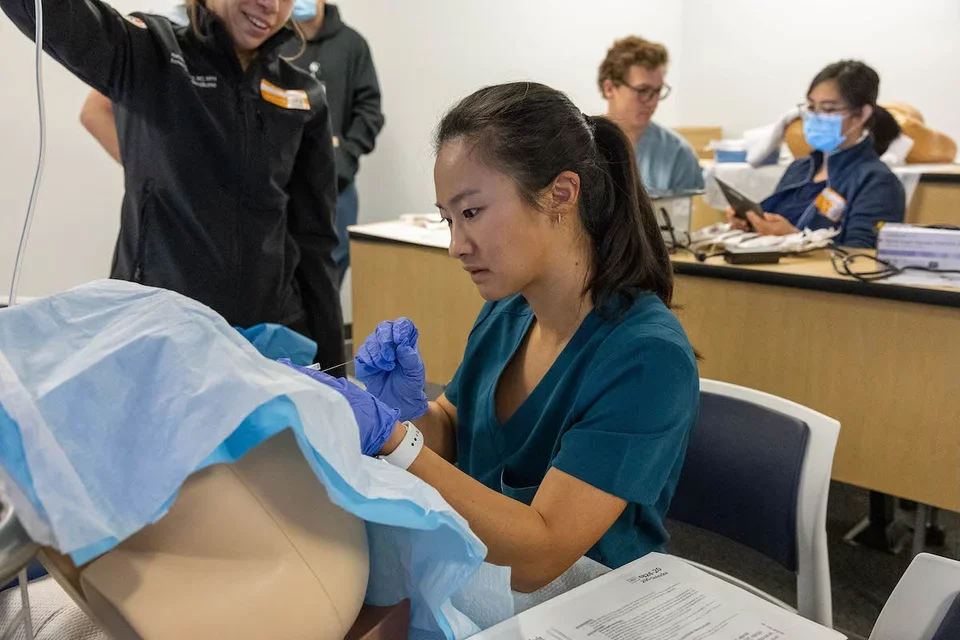Chinese Medicine and Art History Inform One Student’s Approach to Care
Student Spotlight

Meet Chelsea Pan
Chelsea Pan grew up immersed in medicine. Her parents, who practice traditional Chinese medicine, encouraged her interest in science and always answered her curious questions about their practice. Eventually, her curiosity developed into the pursuit of a career in medicine.
Born and raised in Santa Monica, California, Chelsea completed her undergraduate education on the East Coast before returning home in 2020 to attend the David Geffen School of Medicine at UCLA (DGSOM). Proximity to her parents and an openness to diverse medical approaches made the school her top choice.

During her time in medical school, Chelsea has connected even more deeply with her childhood roots in Chinese medicine. She’s been involved with the UCLA Center for East-West Medicine (CEWM) and will spend time before graduating in Hangzhou, China studying integrative medicine with DGSOM’s Global Health Program.
Today, Chelsea’s core values as a medical student and future physician remain grounded in her parents’ early lessons.
“They demonstrated the value of treating the whole person and thinking about diseases in the context of a patient’s life and background,” Chelsea says. “We consider all patient issues and concerns—not just medical ones.”
Fun facts:
- Chelsea and her sister are two years, two months, and two days apart in age. (Chelsea considers 2 her lucky number.)
- She ran her first marathon in medical school.
A Whole-Patient Outlook
Chelsea started medical school in 2020, during the pre-vaccine days of the COVID-19 pandemic. While isolating and uncertain, this challenging phase led to some of her most vivid med-school memories.
She’ll never forget meeting her classmates in person after social distancing for so long, and reflecting on the help and support she and her classmates offered their community fills her with pride. For example, she and other members of the Asian Pacific American Medical Student Association (APAMSA) connected with underserved Asian communities throughout Los Angeles, providing vaccines and addressing concerns.
“It was especially meaningful to connect with immigrant communities, hold vaccine events, and create and distribute mental health brochures,” Chelsea says.

In addition to feeling altruistically rewarding, making a difference in the local community solidified Chelsea’s passion for educating, empowering, and engaging with people like her, whose first conception of medicine formed outside the Western tradition.
Chelsea believes healthcare providers can bridge the gaps between themselves and their patients by acknowledging diverse forms of medicine, understanding how the forms can complement each other, and most importantly, listening. She wants her future patients to feel comfortable sharing what practices have made them feel better.
Incorporating these practices into the patient’s care—when it’s safe and possible to do so—is one way she sees herself championing humanistic medicine focused on understanding instead of mandating.

Matching Into Residency
Chelsea had little trouble choosing a medical specialty in anticipation of applying to residency programs. In internal medicine, she found a field aligned with her core values and scientific interests, a field that lets her practice the compassionate, holistic healing approach she first learned from her parents.
Many students find preparing for residency interviews stressful; Chelsea found it affirming.
“I got to think about my entire journey so far and why I picked internal medicine,” Chelsea explains. “While creating my personal statement, I found it so helpful to think through my story holistically.”
Practicing internal medicine, she’ll explore integrative techniques and continue working with her hands—something she grew to love while creating art growing up and studying art history in college.
“Medicine is both art and science,” she says. “In medical school, we focus on the science. The art comes from relating to people by thinking about culture, emotions, and backgrounds in different contexts, all things I learned how to consider and appreciate while majoring in art history.”

While Chelsea’s specialty decision went smoothly, she ran into more questions and concerns later in the matching process, while selecting potential programs. Fortunately, her DGSOM mentors offered illuminating advice, urging her to reflect on where she would be happiest and which schools would lead to the most opportunities.
They also encouraged her to do the “envelope test,” which helps medical students gauge their feelings about the different residency matches they might find inside their envelopes on Match Day. Students put their program choices into separate envelopes, open them all randomly, and reflect on their different reactions.
Chelsea found the “envelope test” incredibly helpful in finalizing her rank list.
Life After Medical School
Chelsea matched into the internal medicine residency program at the University of California (UC), San Francisco on Match Day in March 2024. While eager and excited to start the next phase of her journey, she’s savoring her remaining time at medical school, enjoying every moment with colleagues and friends who will soon be scattering across the world to pursue their dreams.
Thinking about the friendships they’ve created and the humanistic values they’ve shared fills Chelsea with a sense of gratitude and connection she’ll carry beyond medical school.
“We’ve always looked out for each other,” Chelsea says. “Anyone having a bad day or moment could always count on someone to recognize that and offer help and support.”
She knows she’ll miss seeing her med-school family every day but also can’t help feeling excited for everyone to enter the next phase of their careers. She pictures them all years in the future, offering each other consultation, advice, and support across diverse locations and specialties.
She’s also visualizing a much closer future: the moment, at DGSOM’s commencement, when she’ll finally say aloud the words she’s been saving for so long.
“We made it through medical school. We’re doctors now.”



